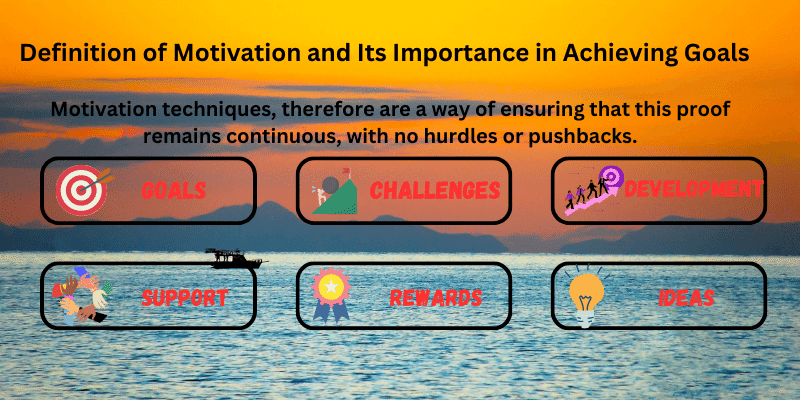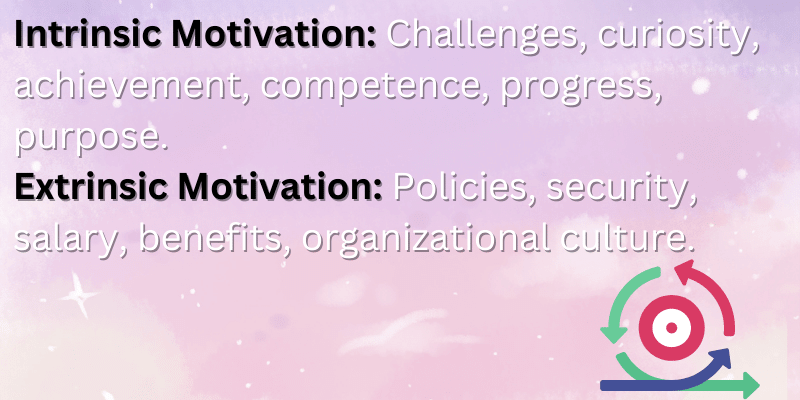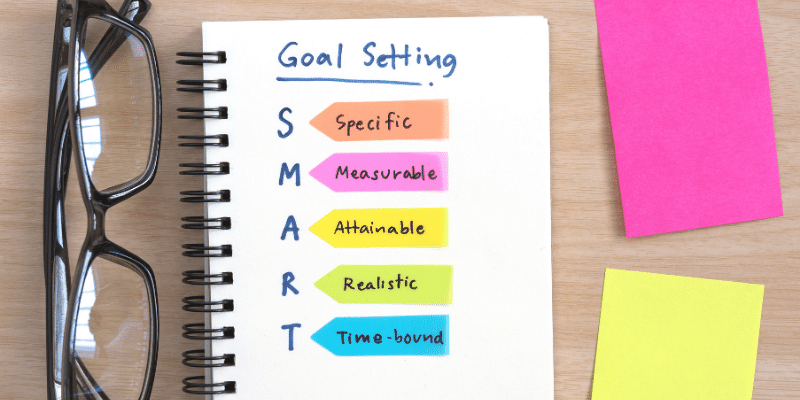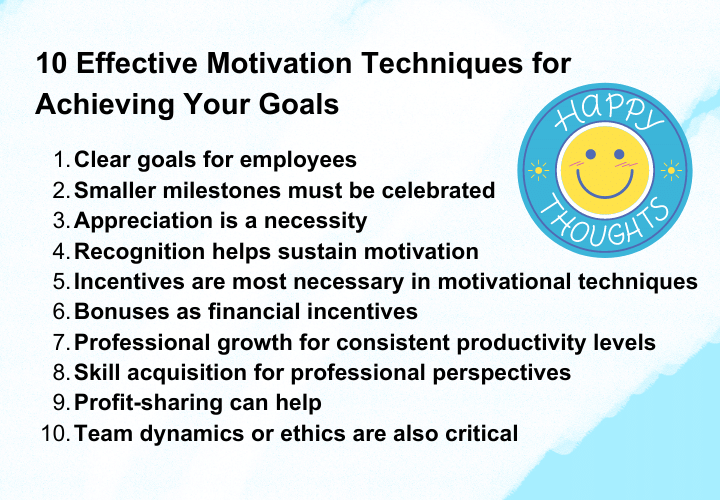Sometimes productivity levels remain low and even mundane tasks concerning life, school, or office are left uncompleted. However, to motivate yourself, you must know that it is both achievable and to keep your employees motivated, you can apply scientifically-approved motivation techniques to increase productivity.
To help you in avoiding employees feeling unmotivated and lethargic, this article has been written with the purpose of setting work goals that motivate employees and your company achieves success.
I. Introduction
Definition of Motivation and Its Importance in Achieving Goals
The field of personality and social psychology defines motivation to be, “A Process”. It is a process because it is an ongoing feeling of initiation, guidance, and goal-oriented thinking in human behavior. In simpler terms, however, motivation is the ability to take action toward an established goal. Motivation techniques, therefore are a way of ensuring that this proof remains continuous, with no hurdles or pushbacks.


The importance of motivation in goal achievement can be understood from the use of scientific terms in research. For most researchers in the field of human psychology, motivational techniques are the only ways to motivate your employees towards goals. Whether it is intrinsic motivation of personality type or extrinsic motivation of benefits, effective motivation is the only way to achieve goals
The Role of Managers in Motivating Employees
The function of a manager in an office is to deal with employees, understand their perspectives, needs, and wants, and then respond with inspiring words and actions. A manager is also a leader who uses employee motivation techniques multiple times to increase motivation and help you achieve your personal goals as an employee, but overall organizational goals are also being achieved.
II. Understanding Motivation Techniques
Types and Core Employee Motivation Techniques
To achieve your goals, motivation is a concept that cannot be applied without any previous understanding. Instead, it is a series of complex human emotions and to stay motivated, there are various techniques and ways to motivate oneself as well as other employees
What Are The Core Employee Motivation Techniques?
The core of each employee motivation technique is based on two types of motivation i.e. intrinsic motivation or extrinsic motivation. While intrinsic motivation is ingrained in the human mind, extrinsic comes from external factors.


Intrinsic Motivation: Challenges, curiosity, achievement, competence, progress, purpose
Extrinsic Motivation: Policies, security, salary, benefits, organizational culture
Types of Motivational Techniques
The foremost and most commonly used type of motivation is Monetary Benefits, which are simply financial gains in response to achieving goals in the workplace. For high performance, bonuses are given, but Recognition and Appreciation are also types of motivation techniques. In this type, the employees stand out among their peers for their abilities and skills. Techniques to help motivate employees also include Team Ethics, Responsibilities, and Organisational Culture.
Positive Motivation Techniques
However, to work harder, motivation tools are not necessarily always meant to be good for employee health. As risks of losing a job or underperforming can be faced by employees. This is why, scientific studies highlight the need for positive motivation techniques that protect the mental health of employees as well
Characteristics of Successful Motivation Techniques
- They cater to employee needs
- They help employees but do not push them
- They are not dominating
- They help if you’re struggling
The Psychology Behind Positive Motivation
There are various theories exploring the psychology behind motivation. Although, the far-reaching opinion remains that the physiological, behavioral, social as well as emotional needs of the person drive them towards the ability to set goals, smaller goals or bigger ones, then energizes them towards achieving those goals and in the end feeling a sense of pride in the achievement of success. Motivation at work is combined with the need of the employee, whether it is financial, emotional, or sociological.
Motivation among workers is also inclusive of internal motivation or external motivation, but irrespective of the stimuli for motivation the ultimate purpose remains the fulfillment of those basic innate needs of money, well-being, security, power, or recognition
III. Proven Motivation Techniques for Managers
Setting Clear Goals and Expectations
In dealing with the challenges of forgotten goals and unmotivated employees, the first barrier is the wrong techniques of goal-setting.
SMART Goal-Setting Technique
If you are going to achieve goals smartly, then follow the SMART technique


- Specific: Goals must be specific to your needs
- Measurable: They cannot be too ambiguous, instead direction toward goal achievement must be clearly defined with each step
- Achievable: The goal must be realistic for the employees, such that they must be able to achieve it
- Relevant: Goals cannot be irrelevant to job needs, specifications, and requirements
- Time-Bound: Set an end date for the goal from the very beginning
Setting Small, Measurable Goals
Motivational tools for ensuring help for employees is to set smaller and achievable goals. It means that instead of telling your workers to simply increase customer numbers, set smaller goals of strategizing advertisements, increasing awareness, and work goals to increase sales numbers.
Providing Regular Feedback


The implementation intention of a work goal for employees is dependent upon how often the employee is being reminded of the importance of goal setting and achieving. One way of doing so is through regularly sharing feedback. To ensure employees are feeling motivated, feedback can bolster their motivation
Motivate Employees with Constructive Feedback
Feedback, even if it is negative, must still be given in a way that does not leave employees to work on criticism. Instead, share criticism in a way that is constructive for improving employees’ skills and meeting employees’ needs.
Importance of Validating Good Work
The process of goal pursuit can be tiring and your employees after getting overworked can desire to achieve goals of rest. In such a case, to keep them motivated, their good work has to be validated and you cannot let your employee think that they are not appreciated at work. Advice and encouragement are key, but to strengthen your commitment to employees, you must also appreciate and recognize them.
Offering Incentives and Rewards


Although, behavioral techniques help, for humans their self-interest is most important
Celebrating Milestones and Achievements
This is why, as soon as employees are able to achieve even a milestone of a larger goal, some form of appreciation through incentives at the workplace, financial benefits, or bonuses can help
Sharing Profits to Improve Performance
Profit sharing is a commonly used technique to motivate employees. The desire to achieve a final goal can get you started if you know that completion will directly benefit you
Recognizing Achievements


For employees, the thing you want to do is to make them feel seen and heard by management. This is why, smaller achievements, even if they hold minimal value, must be celebrated in some shape or form.
Importance of Acknowledging and Appreciating Accomplishments
Appreciation and acknowledgment at the workplace can help you build a positive workspace, where accomplishments are taken as successes. To improve the performance of the workers, appreciation can be critical in allowing for motivation to increase and to help inspire other employees as well.
Ways to Show Appreciation
- Appreciate the employee in weekly or monthly meetings
- Give the employee words of encouragement
- Use their example with other employees
Providing Opportunities for Growth and Development


Motivation, however, does not stop at a singular project, instead, it is ongoing
Employee Motivation Tools
For long-term goals, the motivation factor for employees is to constantly provide them with a long-term roadmap for their careers. This is why, motivation tools are necessary for aligning personal goals to organizational goals
Importance of Educating and Developing Employees
Rewards can also mean incentives for furthering professions for employees. This means that gift cards for the nearby coffee shop can help, but a motivated and productive worker base must be given opportunities for professional growth as well.
IV. Avoiding Common Motivation Traps
Honey Traps of Employee Motivation Techniques
To motivate employees, organizations can make large claims for positive emotions from their workers and achieve the final goal. These are honey traps to lure the worker toward the organizational goal.
Traps to Avoid While Motivating Employees
- Incompatibility: Values between workers and organisation must be similar. However, traps for motivation are mismatched values of the goal and employees
- Incentives: Giving constant financial incentives is not likely to happen in most organisations, therefore making claims can lead to dissatisfied employees
- Self-Efficacy: Not feeling good enough is part of the journal of personality and social values given by employees. Numerous related articles have highlighted that larger goals can be daunting and employees can feel inadequate
Negative Effects of Motivation Traps
The reason why employers must refrain from letting employees fall into such traps is that it can result in dissatisfied and unmotivated workers, with depleting mental health and wellbeing. Under such conditions, research has shown productivity levels to decline, having a consequence on overall organisational efficacy as well.
Dealing With Unmotivated Employees
However, in case employees do get stuck in traps and start to feel unmotivated, there are still a few ways they can be managed
How to Deal with Unmotivated Employees in the Workplace
The foremost strategy must be to envision the change that employees are not seeing, showcasing traits of the Transformational Leader. In envisioning change, you create a future reality where employees also see the achievement of their personal or professional goals, and as a consequence motivation increases.
Techniques for Sustaining Motivation
Once motivated, to sustain motivation among employees, the strategy must be to focus on constant value-setting and growth. Incentives, whether professional or financial, cannot be constantly supported. Instead, to sustain motivation use techniques of appreciation and recognition, along with upgradation in power and authority
V. Creating a Motivating Work Environment


The Role of Managers in Self-Motivation
Motivating Oneself as a Manager
To keep yourself motivated as a manager, focus on the same strategies being used for workers. Consider offering incentives, consequences of goals achievement and challenging tasks
Techniques for Self-Motivation
Attentional focus is key in self-motivation because you highlight what you need or desire, then work towards that goal
Building a People-First Culture
Ways to Engage Employees
Organizational culture is key in ensuring a motivated worker base. The culture must be
- Friendly
- Encouraging
- Non-Toxic
Establishing Clearly Defined Rules and Fostering Collaboration
With workspaces that have game rooms, employees tend to mingle and foster positive working relationships. The use of rules and collaboration is based on the same principle of creating a supportive environment for employees.
Promoting Work-Life Balance and Wellness
Encouraging Mindfulness and Providing Comfortable Workspaces
Some aspects of the workplace can be desirable to some employees and less desirable for others. To tackle this and ensure motivation, the focus must be put on mental health and wellness
Implementing Wellness Programs
To create a motivated and healthy workforce, begin a Human Resource program for employee wellness. The program can be as minimal as simply providing an ear to employees to let off steam or can be extensive and include check-ups, strategizing, and implementation of wellness programs.
VI. Conclusion
Recap of the 10 Effective Motivation Techniques
- Clear goals for employees
- Smaller milestones must be celebrated
- Appreciation is a necessity
- Recognition helps sustain motivation
- Incentives are most necessary in motivational techniques
- Bonuses as financial incentives
- Professional growth for consistent productivity levels
- Skill acquisition for professional perspectives
- Profit-sharing can help
- Team dynamics or ethics are also critical
Importance of Motivation in Achieving Goals
Motivation is critical in ensuring goal achievement. The way it works better results from goals motivate employees to remain focused. This is why, when establishing goals for organizational growth and productivity, make sure to also strategize for employee motivation.
Encouragement to Implement These Techniques for a Motivated and Productive Workplace Environment
The techniques discussed in this article are scientifically backed and proven to be effective for employee motivation. This is why, instead of investing in research and development, take out time to analyze your employees’ needs, whether they are entirely financial or appreciation, recognition and skills acquisition are also important. Finally, apply what fits.
FAQ’s
Q. What are 5 Ways to Increase Motivation??
- Offer clear goals
- Set milestones that are achievable
- Appreciate small wins
- Recognize hard-workers
- Offer incentives and rewards
Q. What are 3 Methods to Motivate the Unmotivated??
- Build strong bonds
- Listen to their perspective
- Provide feedback
Q. What are the 5 Types of Motivation??
- Physiological motivation
- Emotional motivation
- Creative Motivation
- Professional motivation
- Sociological motivation
Q. What are the 4 Motivation Styles??
Depending on your personality, there are four ways you can face motivation:
- Obliging: They are open to challenges and remain motivated to meet expectations
- Questioner: To be motivated, they need more information, justifications and reasoning behind the work at hand
- Rebel: They resist. To motivate them, goals must be identity related and direction has to be established by them only
- Upholder: They uphold trust of the employer. They strive to achieve goals before being told to.
Q. What are the 5 Motivations??
- Physiological motivation
- Safety Motivation
- Love and belonging
- Self-esteem motivation
- Self-actualisation motivation
Q. List Down 7 Types of Motivation That Hold Great Value??
- Emotional
- Physiological
- Sociological
- Professional
- Creative
- Fear
- Power imbalance
Q. What are the 4 Basic Motivations??
- Need for safety
- Need for food, water and wellness
- Need for recognition
- Need for self-esteem
Q. What are the 6 Types of Motivator??
- Meaningfulness
- Recognition
- Compensation
- Culture
- Team dynamics
- Working benefits
- Financial gains



